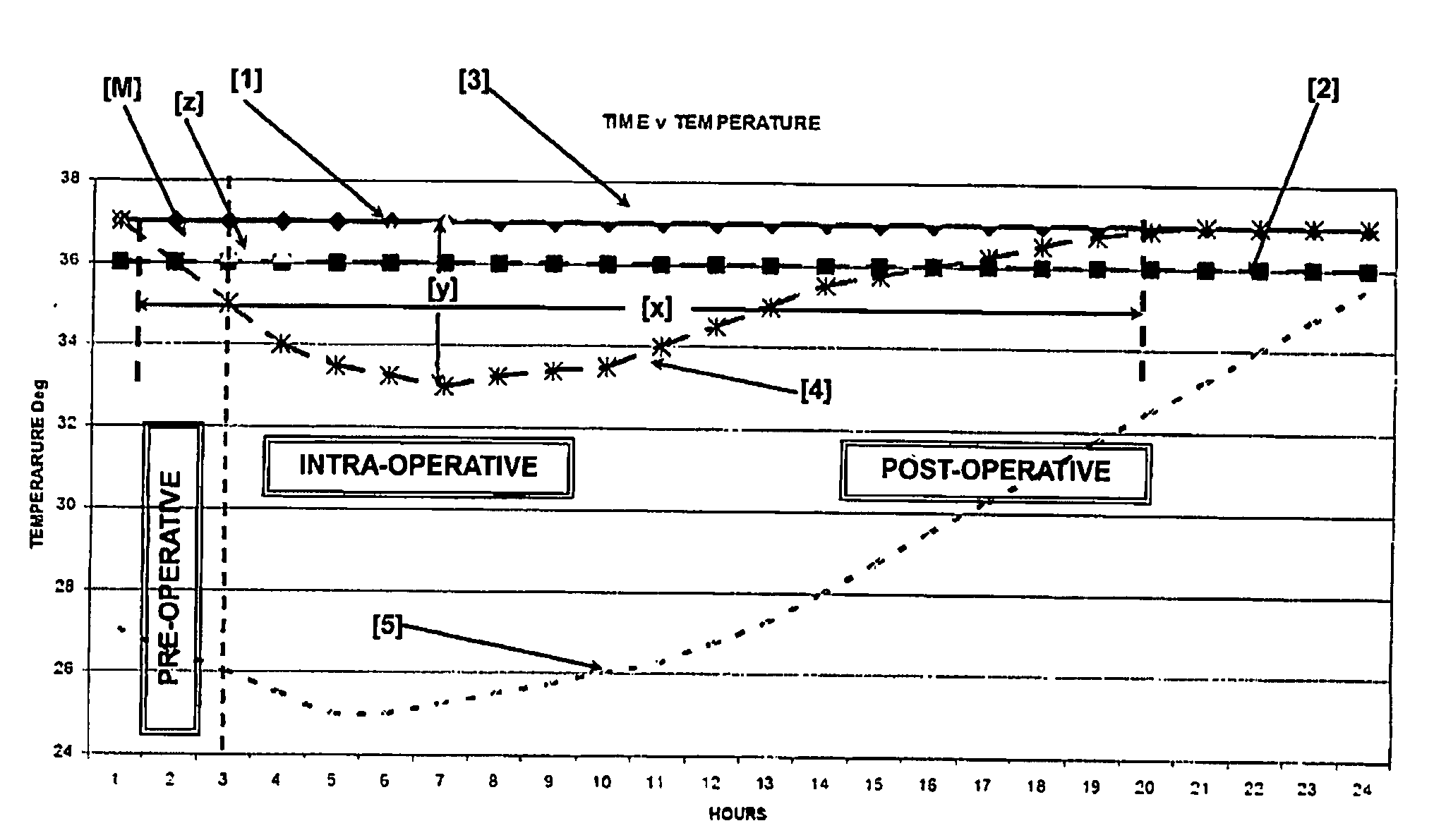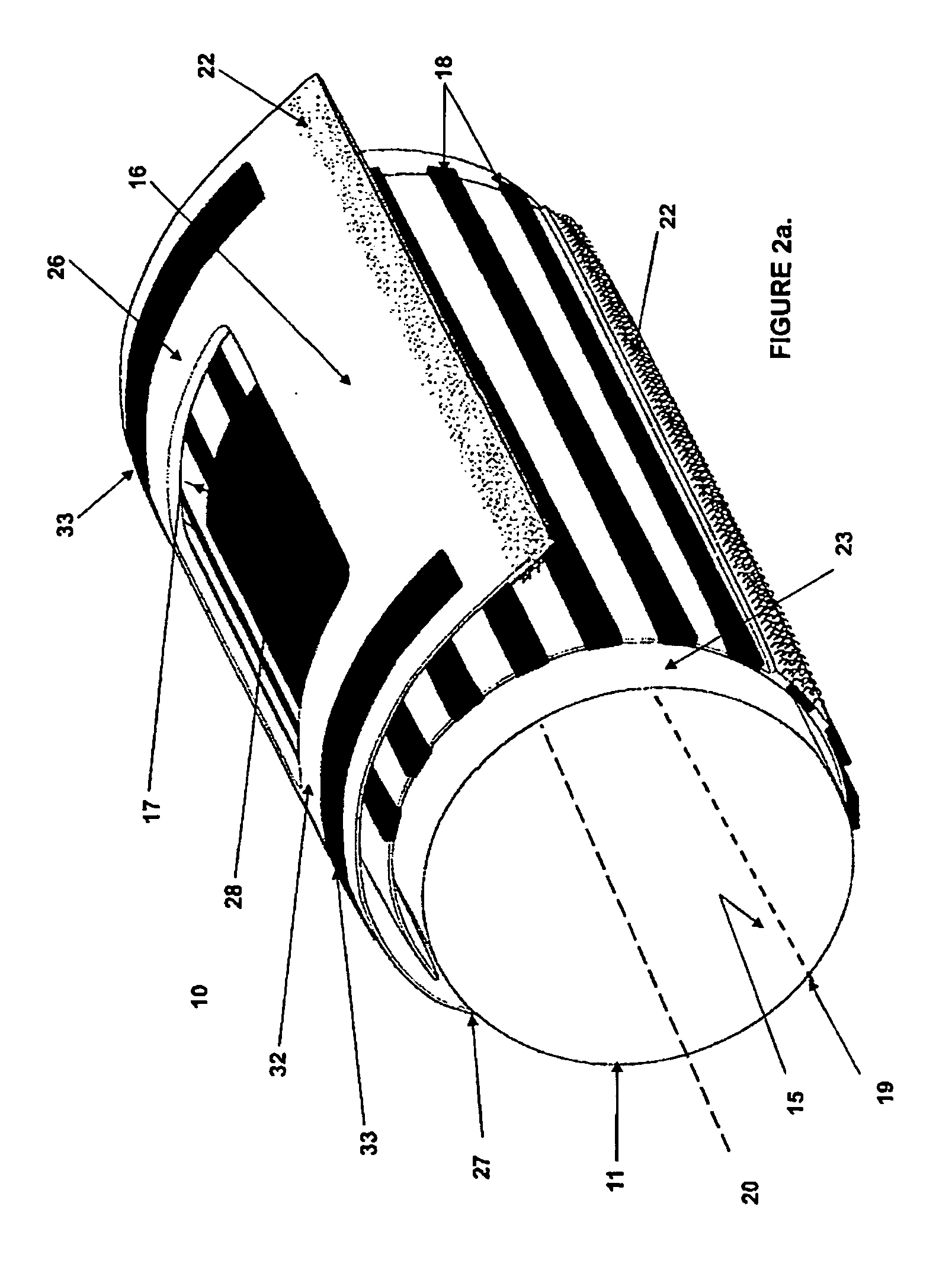The inventors believe that prior art in this domain fails to adequately address the specific practicalities of the surgical environment which failure significantly contributes to the development of patient
hypothermia.
However,
vasoconstriction makes it much more difficult to reverse a hypothermic state since
vasoconstriction impedes the transfer of heat from the
body surface to the thermal core and makes it difficult to simply apply heat to the surface of the body.
Surgical garments currently in use are not conducive to insulating the body, or to the maintenance of normal body temperature.
They are often skimpy, poorly fitting, garments, open at the back, with minimal coverage of the patient's extremities and severely compromise the patient's modesty and self-respect: all of which contributes to the patient's
anxiety and heightens sensitivity to external stimuli in an unfamiliar environment.
The patient is then left in an alien environment, partially clothed and potentially hypothermic which again results in a relatively high level of
anxiety.
Practically, this physiological response creates difficulties in inserting intra-venous (IV) cannulas in the
ambulatory / pre-surgical holding area as well as compounding the difficulties of efficient monitoring of
oxygen saturation in the operating room with application of
pulse oximeters to the digits.
The inventors conclude that these environmental and physiological factors contribute to normothermic degradation prior to anaesthesia, while significantly increasing the difficulties of
patient care.
In addition, incremental developments in surgical technique, driven by technological advances are changing the timing of patient
throughput.
Industry literature widely acknowledges that, except in cases where
tissue degeneration is deliberately arrested by cooling,
hypothermia is generally detrimental to patient
recovery and may put life at risk and this is reflected in a large number of learned publications.
In a paper entitled “Effects of
perioperative hypothermia and warming in surgical practice”, published in International Wound Journal, 2(3): 193-204, (2005) Kumar et al, reported: “
Perioperative hypothermia is common and adversely affects clinical outcomes due to its effect on a range of homeostatic functions.
Traditional medical surgical garments fail to offer the necessary insulative construction or material properties to be able to maintain normothermic body temperature in this environment.
Equally controversial is the value of prophylactic
antibiotics in preventing postoperative
wound infection; there is no clear
cut evidence of
efficacy and some random controlled trials have shown no differences at all . . . . An alternative to
antibiotics is the systemic warming of patients or the local warming of the operative site prior to
surgery.”
However, prior art in this field has created conflict between the practical application of existing garments and blankets and peri-
operative surgical procedures which detrimental combination conspires to reduce the
efficacy of the heating process and simultaneously creates significant levels of additional complexity in the surgical environment.
Thoracic and / or abdominal surgical operations typically allow only a portion of the
torso to be covered during the procedure, which therefore reduces the effectiveness of existing heating devices.
Furthermore,
blanket type devices tend to apply zoned heating such that in the zones which are removed or de-activated there is, effectively, no patient heating and therefore significant potential for areas of the patient's
torso to be subjected to significant heat loss.
Such heat blankets also leave the patient's arms uncovered, thereby contributing to further increases in heat loss.
Additionally,
blanket type devices provide unwanted heat and
noise to the environment of the operating room, to the detriment of the surgical staff.
However, these devices are typically
inflatable which increases the bulk of the patient in the surgical environment, encroaching on the available space in the operating room and creating significant difficulties for the
surgical team.
The umbilicals themselves create additional, unwanted complexity in the surgical environment and
pose significant, attendant Health & Safety Hazards.
Other embodiments which promote normothermia by
heat transfer from circulating
hot liquids around garments also disadvantageously require umbilicals and additional
tethering.
These physical and temporal windows, typically of at least 10 minutes duration, leave the patient's
torso without
thermal protection and therefore subject to considerable detrimental heat loss.
In addition and when deploying existing heating methods and systems,
surgical procedures conducted on the torso frequently leave only a portion of the torso actively heated, or the lower extremities alone, thereby reducing the
efficacy of the heating device.
The inventors deduce that despite their application, existing systems and methods for maintaining normothermia often contribute to intermittent hypothermia resulting in sustained detrimental reduction in core and
peripheral temperatures which the body has difficulty reversing.
The inventors therefore conclude that existing systems are economically wasteful and propose a method and
system which does not require inter-operative intervention nor result in unnecessary wastage.
The inventors perceive that inadvertent harm may befall the patient as a result of the protracted
delay in applying heating.
In addition, the requirement to fit existing devices in situ detracts from the
workflow of the operating room.
The inventors observe that tethered devices contribute significantly to increasing the complexity of the operating room.
Additionally, in a study reported in the Canadian Journal of
Surgery 53(3): 189-195, June 2010, by Wong et al report that the most common cause of
delay in the operating room was attributable to equipment failure.
Anderson's device, while apparently increasing the versatility of
forced air warming devices may also unfortunately impede patient monitoring as
pulse oximetry devices typically require access to the fingers, which access may be impeded by the patient's hands being enclosed within the inflated garment.
Although this increases the versatility of the heat emitter, it requires a
dual mode forced air warming device
machine which is attached via bulky umbilicals and which significantly leaves more of the
body surface area, (BSA), unheated than is practically heated.
Additionally, such devices create significant undesirable environmental
impact in the operating theatre.
Surgical, patient and environmental control devices may have undesirable bi-products in the form of increasing the heat and
noise of the operating room environment.
In addition, Albrecht et al, reporting in the American Journal of
Infection Control 39(4), 321-328, in May, 2011 concluded that incorrect selection or inadequate installation procedures on the air filters used on
Forced Air Warming devices can lead to increased levels of airborne
microbial contaminants.
Additionally, they concluded that there was little evidence that the efficiency of the air intake filter was adequate to protect the internal air path from buildup of
microbial contamination within the machinery of the FAW.
This, then, requires the FAW to be serviced by a
technician, further adding to the cost and
service personnel requirements of the operating room.
Forced Air Warming, “FAW”, devices, due to their
inflatable nature, are inherently unstable so that a cotton
blanket is almost invariably applied over the device.
Perversely, the blanket is maintained in a warming
closet and also requires recycling thereby further adding to procedural costs.
In this event, the unmonitored loss of effective warming is a further draw-back of existing FAW devices.
Additionally, it does not require a static multi-patient device which requires constant servicing and electrical certification by trained biomedical engineers, which further adds to per-case cost as well as fixed facility overhead.
This device has some advantageous design elements, in particular its lack of requirement to be attached by an umbilical, but, being a blanket it still has the potential to impinge on or contaminate the sterile surgical field and has limited application in the pre-surgical,
ambulatory, holding area.
This device, like all of the blanket devices, has placement issues, it being positionally difficult to control during surgery.
However, the blanket is unnecessarily wasteful in that the detachable areas are disposed of without being used, thereby unnecessarily increasing total
unit cost.
Salmon also claims the
advantage of included pulse-oximetry sensors; however, Salmon fails to address the issue of IV access for administration of intravenous fluids.
In addition, detrimentally, Salmon proposes the application of heat to only one hand which the inventors assert is insufficient to combat hypothermic onset.
This therefore requires the tethered attachment of both of the patient's arms and a lower extremity to external loci, which has detrimental
impact on the surgical environment.
Although designed for
therapeutic treatment, the device would prove problematic in the surgical environment as the gel filled elements preclude intra-venous catheterization.
Haensel's device incorporates transfer paths, heat positioners and energy state changes, which represent a considerable degree of complexity.
 Login to View More
Login to View More  Login to View More
Login to View More 


